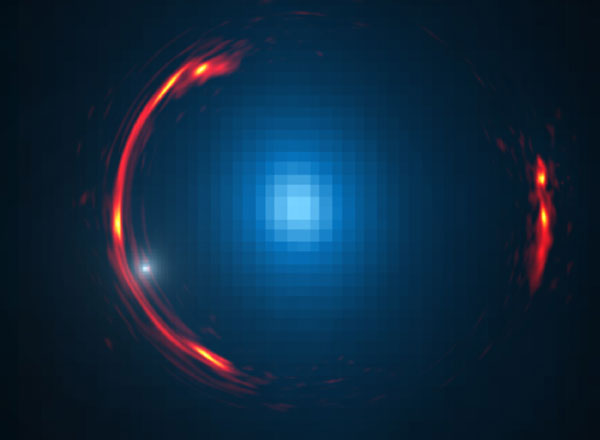Astronomers using the ALMA array of radio dishes have detected a dwarf galaxy 4 billion light-years away by the pull of its dark matter.
A long time ago around a galaxy far, far away, a dwarf galaxy awaited discovery. This miniature galaxy is almost entirely dark matter dominated — it contains few, if any stars. Only by combining the power of dozens of radio dishes high in the Atacama Desert in Chile could astronomers spot the dark dwarf’s gravitational mark.

Y. Hezaveh (Stanford Univ.) / ALMA (NRAO / ESO / NAOJ) / NASA / ESA / Hubble Space Telescope
About a year ago, a team of astronomers imaged a tiny ring in the sky just 3 arcseconds across. This ring was actually the gravitational distortion of light from a distant background galaxy. A massive elliptical much closer to Earth, dubbed SDP.81, acted as a gravitational lens, bending the background galaxy’s light into a circle.
The Atacama Large Millimeter/submillimeter Array (ALMA) imaged this ring in stunning detail, one of the first ultrasharp images to be collected using the array’s longest 15-kilometer baseline. (Read “Ring-Shaped Spyglass to Early Universe” for more information on the original image.)
Now another team, led by Yashar Hezaveh (Stanford University), has employed the Blue Waters supercomputer to analyze the same set of data — and to make a surprising discovery.
Hidden within the depths of the background galaxy’s distorted image, Hezaveh and colleagues have found the unmistakable signature of a dwarf galaxy with the mass of a billion Suns. The dwarf, which orbits the massive lensing galaxy SDP.81 — not the more distant galaxy — made its presence known by its additional, subtle distortion of the background galaxy’s light. Hezaveh’s team also found hints of even smaller dark matter clumps floating in SDP.81’s halo.
All together, the clumps of dark matter around SDP.81 match what’s expected from simulations modeling the evolution of the universe in the presence of dark matter. That’s something of a surprise considering that the number of dwarfs found around the Milky Way is much lower than those models predict, the so-called missing satellite problem. Then again, astronomers still depend on light to detect diminutive galaxies around our own — it's likely that they’re missing dark galaxies that emit little if any light, and they're already well on their way to upping the tally to a more comfortable number.
In a press release, team member Joaquin Vieira (University of Illinois at Urbana-Champaign) hailed the discovery as “the most sensitive picture of dark matter ever.” The international collaboration is already looking forward to applying their novel technique elsewhere, on the hunt for dwarfs around other gravitational-lens galaxies.
Reference:
Y. Hezaveh et al. “Detection of Lensing Substructure Using ALMA Observations of the Dusty Galaxy SDP.81.” Accepted for publication in Astrophysical Journal.
 3
3









Comments
Jon Seamans
April 20, 2016 at 12:24 am
According to https://public.nrao.edu/news/pressreleases/alma-ring-lens, the maximum resolution, the 23 mas ≈ width of SD.81, not it's diameter as I interpreted in your post:
"For these observations, ALMA achieved an astounding maximum resolution of 23 milliarcseconds, which is about the same as seeing the rim of a basketball hoop atop the Eiffel Tower from the observing deck of the Empire State Building."
You must be logged in to post a comment.
Jon Seamans
April 20, 2016 at 1:22 am
Mmmm... I'm confused by the NRAO article. Per the quote, 23mas is the right magnitude for the basketball hoop diameter. However, since SD.81's rim is substantially resolved, the maximum resolution must be substantially less than 23mas.
Looking at Hezaveh's paper (Figure 4), the ring scale is revealed to be just over 3 arcseconds diameter. This is consistent with a maximum ALMA resolution of 23mas. I have to believe Hezaveh,
You must be logged in to post a comment.
Monica YoungPost Author
April 20, 2016 at 4:20 pm
You are both correct (as is Hezaveh, of course) - the ring is 3 arcseconds across, it's the details within the ring that are 23 milliarcseconds across. Apologies for the confusion!
You must be logged in to post a comment.
You must be logged in to post a comment.